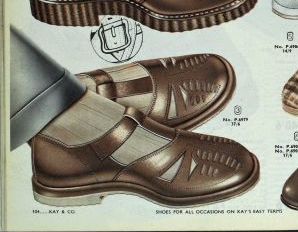GoldenEraFan
One Too Many
- Messages
- 1,164
- Location
- Brooklyn, New York

Number 5 on this page: http://www.worldofkays.org/website/1781
has rubber soles and heels. It's a black Oxford from 1947.
 John Lofgren Monkey Boots Shinki Horsebuttt - $1,136 The classic monkey boot silhouette in an incredibly rich Shinki russet horse leather.
John Lofgren Monkey Boots Shinki Horsebuttt - $1,136 The classic monkey boot silhouette in an incredibly rich Shinki russet horse leather.  Grant Stone Diesel Boot Dark Olive Chromexcel - $395 Goodyear welted, Horween Chromexcel, classic good looks.
Grant Stone Diesel Boot Dark Olive Chromexcel - $395 Goodyear welted, Horween Chromexcel, classic good looks.  Schott 568 Vandals Jacket - $1,250 The classic Perfecto motorcycle jacket, in a very special limited-edition Schott double rider style.
Schott 568 Vandals Jacket - $1,250 The classic Perfecto motorcycle jacket, in a very special limited-edition Schott double rider style. Ish: which shoe are you referring to? As noted in my post, i was referring to the black Oxford (i.e. on the right hand page) which can hardly be described as "Worn for hikes outdoors through fields and cobbled roads." (the illustration at the top of the page - a man in the city - also suggests it is for city use rather than country). I think you are confusing it with the page of shoes for country wear.
N.B. I don't think the original post made specific reference to crepe or commando soles, it simply says "rubber soles".
look at the pics he used. What's the point in stating that shoemakers have used rubber as well as leather as shoe sole material? This isn't groundbreaking information. In this vein, we can have a thread dedicated to "all leather shoe interiors" in vintage shoes. We all know most shoemakers used canvas on interior linings and today top makers prefer leather. Doesn't speak at all on quality, styling or anything else except trends. There was a run where shoemakers experimented with different materials for soles and heels to achieve durability and less slip. Today leather is favored. Not really worthy of discussion, though.
Why do you appear to be criticising my decision to post a link to rubber soled dress shoes in a thread entitled 'Examples of rubber soled dress shoes in the Golden Era.'? Someone made an observation, someone else follows up with links - that's what we are here for. Please remember that, whilst you may have a deep knowledge of vintage shoes (and almost certainly know more than most of us), there are plenty of people on this forum who are still eager to learn.
And, if rubber was such a common thing in the period, why are their so few examples of rubber soles on the more formal shoes in the Kays catalogues that I was referencing?
Furthermore, if this is a subject you consider unworthy of discussion, why have you bothered to post in this thread?
P.S. I think having a thread on 'all leather shoe interiors' would actually be a good thing. If you were to put such a thread together - explaining the changing trends and the reasons for the changes - I would certainly read it.
Your reference to canvas interiors interests me: my personal experience is that leather interiors are superior simply because leather lasts longer before wearing out (i'm comparing my experience of different shoes made in the same factory).
Personally, I prefer rubber soles, favouring 'golfer soles' over commando soles or smooth rubber. My preference is two-fold: it rains a lot here and leather soles are treacherous in wet weather (try walking two miles to work on rain and leaf covered pavements in London in November and you'll soon get the idea) also I cycle a lot and leather soles slip on the pedals.
On the point of whether there is a need for a thread on rubber soles, I disagree with your assessment. The subject interests me simply because I have regularly seen rubber soles being dismissed as being 'not correct period style'. As you have rightly pointed out, rubber soles have been widely used at different times with varying degrees of success/popularity. Thus, a thread showing rubber soles worn in the period under discussion helps to undermine the fallacy that rubber soles weren't used. I'm always in favour of any thread that broadens readers understanding of period fashions. I am sure that was the intention of the original poster.
Anyway, the thread has proved its worth since you have referred to trends from certain periods that I wasn't aware of (v cleats in the 1950s etc). I'm always happy to learn something new.
